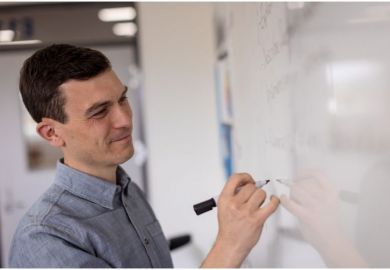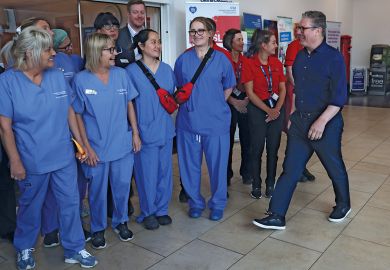The Ivy League has dropped racial and religious bars, but cash still counts, says Simon Baatz
Even a cursory glance at the world university rankings reveals that the eight Ivy League institutions have established a pre-eminence unmatched by any comparable group.
These universities pride themselves on their high academic standards, research productivity, small class sizes, superior libraries and research laboratories, and the success of their alumni. Seven of the eight Ivy League members - Brown University, Columbia University, Dartmouth College, Harvard University, the University of Pennsylvania, Princeton University and Yale University - were established in colonial times, before the US itself came into existence. Cornell University, founded in 1865, is a latecomer that has, nevertheless, earned a reputation equal to that of the others. Only two - Cornell and Penn - have secular origins; the other six began as theological academies.
The 19th-century American college was a parochial affair, attracting applicants from its immediate vicinity only: Bostonians attended Harvard; New Yorkers enrolled at Columbia; and Philadelphians applied to either Penn or Princeton. Towards the end of the century, as the German research ideal gradually transformed the college environment into one more closely resembling that of a university, and as university education became more immediately relevant for professional success, American universities became national, rather than regional, institutions.
Yet, at least before 1900, only the sons of the wealthy - those who had been able to afford the necessary academic preparation - could gain admittance to the Ivy League. Not until the first few decades of the 20th century, after the advent of universal public high-school education, did other, less prosperous, applicants attend Harvard, Yale, Columbia, Penn and Princeton.
There was in the 19th century an anti-intellectual atmosphere and an antipathy to serious study even at the best universities. Fraternities and student clubs dominated campus life, and sports, especially intercollegiate American football, were immensely popular. Academic success was unimportant; those few students who had no inclination to join a fraternity and who preferred to spend their time studying earned the derision of their peers. The student body was overwhelmingly Protestant, white and male. Yet changes in American society could not fail to affect even the elite universities: the arrival of many millions of immigrants from eastern and southern Europe altered the demographic make-up of such cities as Boston, Philadelphia, New York and Baltimore.
Charles Eliot, president of Harvard from 1869 to 1908, had overseen the introduction in 1906 of a more democratic and equitable admissions system with the adoption of the College Entrance Examination Board. Harvard could now select its applicants from a wider area and could choose whom to admit on the basis of meritocratic criteria. Yale followed suit in 1916 when it abandoned its own set of exams in favour of those recommended by the College Board. Change was apparent even at Princeton, where Woodrow Wilson attempted to restrict the influence of the eating clubs and to dilute the snobbishness and exclusivity that pervaded the campus.
Such moves would open the Ivy League to a wider and more diverse pool of applicants, yet the presidents of Harvard, Yale and Princeton feared that a more open admissions policy would threaten the demographic foundations on which their colleges had been built. Jewish students, especially, were viewed as threatening.
The putative threat resulted in a rapid overhaul of the admissions system at Harvard, Yale and Princeton in an attempt to reduce the numbers of Jews at each college. Admission was no longer based solely on academic merit but also on a range of other factors. How congenial was the applicant? What leadership qualities did he possess? Applicants had previously been required to pass an exam as a condition of admittance. Now each applicant had also to divulge his race, colour, religious preference, the birthplace of his father, all previous surnames used by his family and the maiden name of his mother - all in the name of an explicitly anti-Semitic and racist policy of exclusion.
Candidates had to supply letters of recommendation; it helped if they could demonstrate evidence of extracurricular activities. Harvard required that a photograph be supplied as part of the application and suggested that each candidate arrange an interview with an admissions officer. For the next 40 years, Harvard, Yale and Princeton were all able to preserve their constructed self-identities as strongholds of white, male, Protestant exclusiveness.
The universities' ideal of rugged manliness survived at least until the Cold War, but in the 1960s it started to fracture as the events of that decade began to transform American society. The exclusive character of Harvard and Yale was to become more and more of a liability at a time when other more egalitarian universities were increasingly opening their doors to groups that had by and large been previously excluded: women, African-Americans, Asian-Americans and Jews.
The launch of Sputnik and the Soviet threat focused attention on a supposed education gap between the US and the USSR (in favour of the latter). One way to close that gap was to emphasise the importance of science and education and, in such a changed context, universities that continued to rely on such intangible qualities as character ran the risk of sinking into a sea of mediocrity.
American colleges now constitute microcosms of diversity and, in this respect, at least, they reflect the larger society. But there is still, as Jerome Karabel recounts in this engaging and informative book, an alarming absence of class diversity within the leading private universities in the US. Fifty per cent of the student body at Harvard, Yale and Princeton come from the top 5 per cent of the nation's wealthiest families. Few students (18 per cent) at Harvard come from families earning less than $60,000 (£31,800) a year.
The elite universities are more accessible than they were 80 years ago, but there is still some way to go before they can be said to fairly represent economic differences within American society.
Simon Baatz is visiting associate professor at George Mason University, Virginia, US.
The Chosen: The Hidden History of Admission and Exclusion at Harvard, Yale, and Princeton
Author - Jerome Karabel
Publisher - Houghton Mifflin
Pages - 711
Price - $28.00
ISBN - 0 618 57458 1
Register to continue
Why register?
- Registration is free and only takes a moment
- Once registered, you can read 3 articles a month
- Sign up for our newsletter
Subscribe
Or subscribe for unlimited access to:
- Unlimited access to news, views, insights & reviews
- Digital editions
- Digital access to THE’s university and college rankings analysis
Already registered or a current subscriber?



